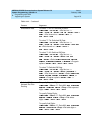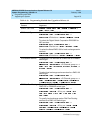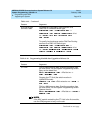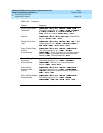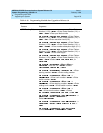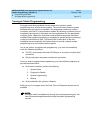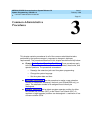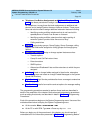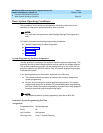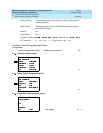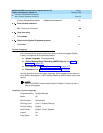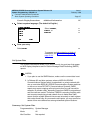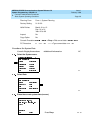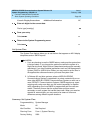
MERLIN LEGEND Communications System Release 6.0
System Programming
555-660-111
Issue 1
February 1998
Common Administrative Procedures
Page 3-2
3
■ Telephone Line Button Assignments and Optional Telephone Fea-
tures. Use these procedures to assign outside lines/trunks to the buttons
on a telephone, to copy these line/trunk assignments to additional tele-
phones, and to assign System Access or Intercom buttons. These proce-
dures can also be used to assign additional extension features including:
— Identifying analog multiline telephones that do not have built-in
speakerphone or Hands Free Answer on Intercom
— Identifying analog multiline extensions that require pairing of
extension jacks to provide Voice Announce to Busy
— Calling restrictions
■ Groups. Assign pickup groups, Group Paging, Group Coverage, calling
groups, and lines/trunks assigned to calling groups and change group
options.
■ Systemwide Features. Assign or change system features such as:
— Transfer options
— Camp-On and Call Park return times
— Extension status
— SMDR options
— Allowed and Disallowed Lists and the extensions to which they are
assigned
■ Labeling. Create or change labels assigned to lines/trunks, extensions
and calling groups and create or change Posted Messages or the System
Speed Dial Directory.
■ Night Service. Night Service provides after-hours coverage to extensions
and calling groups
■ Fax Machines. Install a fax machine and set options for message-waiting
indication.
The programming procedures needed to perform these tasks are described in
detail in the remainder of the chapter. More advanced programming procedures
such as adding lines/trunks, are described in detail in Chapter 4, “Programming
Procedures.”
Each of the procedures begins on the System Programming menu. Use one of the
methods shown below to display the System Programming menu.
■ At the console: Menu→ →
■ At the PC or with SPM: Type →
Press any key
→ →
Before you begin any of the procedures in this chapter, you should read and
understand all of the information presented in Chapter 1, “Programming Basics.”



